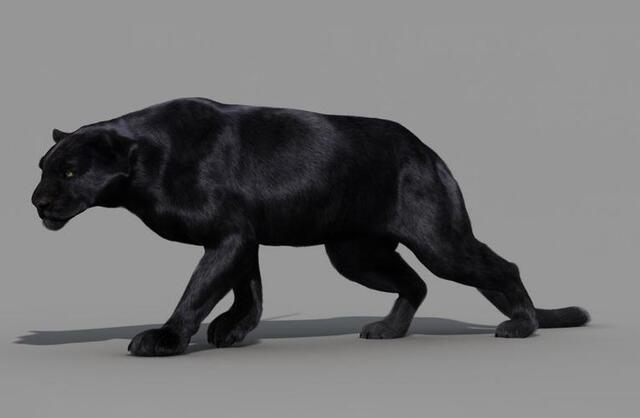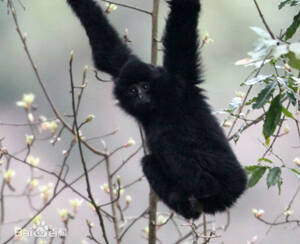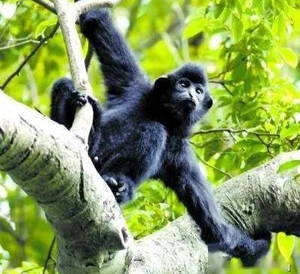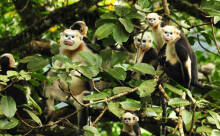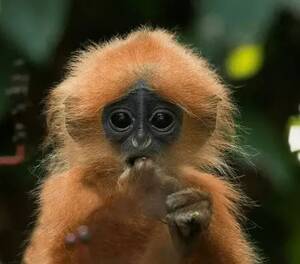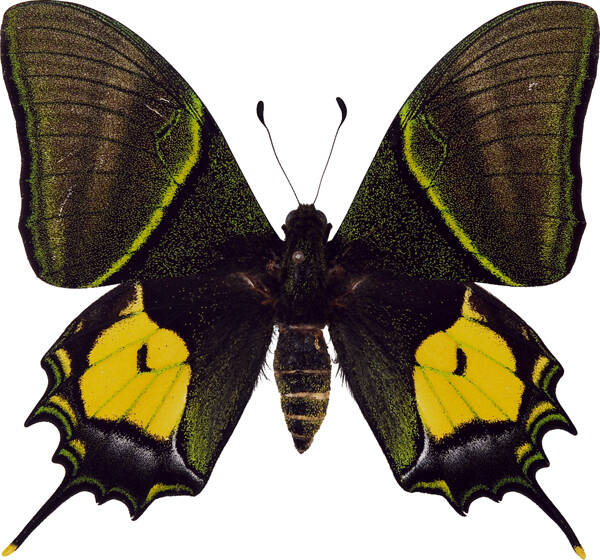Priodontes maximus
IUCN
LCBasic Information
Scientific classification
- name:Priodontes maximus
- Scientific Name:Priodontes maximus、P.giganteus、Armadillo、qiú yú、Armored rat
- Outline:protectorate
- Family:Edentata Armadillodae P.Armadilloinae Vertebrata
Vital signs
- length:12.5-100cm
- Weight:Up to 50 kg or more
- lifetime:10+ years
Feature
Exoskeleton features: The armadillo's body is covered with a layer of hard and uniform scales, which is their natural protective armor and can effectively resist external damage. They have relatively large heads, a pair of pointed beaks and sharp claws. Most species of armadillos mainly feed on insects, but also eat invertebrates and small vertebrates, or plant food. Armadillos have powerful molars in their mouths that can easily bite hard plant fibers. Life habits: Armadillos are nocturnal animals. They usually rest in tree holes or burrows during the day and come out to move and forage at night. They like to live alone and usually only meet other armadillos during the mating season. During the breeding season, male armadillos will use their special snoring to attract the attention of female armadillos. After mating, they go their separate ways again. A female armadillo usually gives birth to four cubs after one fertilization. All cubs born in the same litter are of the same
Distribution and Habitat
Distributed in the southern tip of South America, the Caribbean coast, Central America, etc., they often live in dense bushes, grasslands, wilderness, etc., and have a very strong adaptability.
Appearance
The armor on the body is composed of many small bone pieces, each of which has a layer of keratin. The bone armor covers the head, body, tail and the outside of the legs. The bone armor on the head, front half and back half is separate, and the bone armor in the body is in the shape of a belt and is extremely hard. Although the whole body of the armadillo is covered with hard armor, it can move flexibly and even run fast; only the bone scales on the shoulders and hips are formed into a whole, like a tortoise shell, and cannot be stretched; while the scales on the chest and back are divided into petals, connected by muscles. There are sparse hairs on the body without bone armor; there are strong claws on the front feet. The armadillo is named after the nine layers of belt-shaped things on its body.
Details
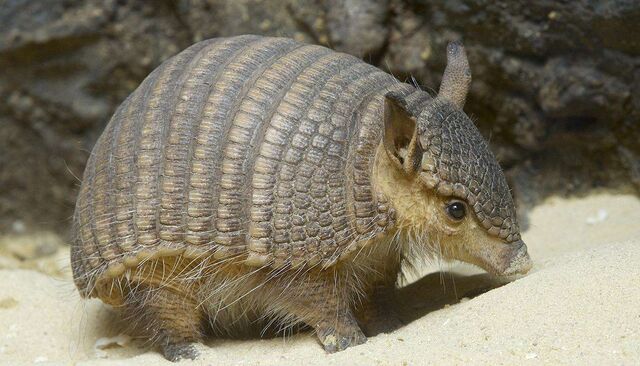
Armadillo (scientific name Priodontes maximus or P.giganteus) is also known as Armadillo in Chinese (qiú yú in pinyin). It is a mammal of the family Armadilloidae in the order Edentata. There are 9 genera and 21 species in the family Armadillo (1 genus and 1 species are extinct): naked-tailed armadillo, round-headed dwarf armadillo, hairy armadillo, dwarf armadillo, armadillo, six-banded armadillo, giant armadillo, three-banded armadillo, and small armadillo. The armor on the body is composed of many small bone pieces, each of which has a layer of keratin. The bone armor covers the head, body, tail and the outside of the legs. The bone armor on the head, front half and back half is separate, and the bone armor in the body is in the shape of a belt and is extremely hard. Although the whole body of the armadillo is covered with hard armor, it can move flexibly and even run fast; only the bony scales on the shoulders and hips are integrated, like a tortoise shell, and cannot be stretched; while the scales on the chest and back are divided into petals, connected by muscles. There are sparse hairs on the body without bony armor; there are strong claws on the front feet. The armadillo is named after the nine layers of bands on its body.
Armadillos are distributed in the southern tip of South America, the Caribbean coast, and the Central American continent. They often live in dense shrubs, grasslands, wilderness, tropical forests, grasslands, semi-deserts, warm plains and forests, and have strong adaptability. Armadillos are burrowing animals that dig holes underground to live, hiding during the day and coming out at night. They have poor eyesight, but excellent sense of smell and can accurately find anthills. Armadillos feed on a variety of animals, such as insects, worms, lizards, etc., and sometimes also eat plant roots. The female armadillo is fertilized once, and lays four eggs and four litters. The gestation period is 8 months, and the longest is 20 months. The life span is more than 10 years.
An armadillo can eat 100 kg of poisonous spiders, scorpions, ants, beetles and other insects in a year, which plays a positive role in pest control to a certain extent. In addition, scientists have extracted leprosy from it and made leprosy vaccines, which has played a great role in human control of leprosy. Moreover, armadillos are easy to domesticate and are one of the precious animals for modern medical experiments.
Morphological characteristics
The armadillo is a small mammal of the family Armadillo in the order Edentata. It is closely related to anteaters and sloths and protects itself with armor-like bone armor. The family Armadillo is widely distributed in the southern United States and South America. It is covered with joint strips or horny bone plates and can curl up into a ball to protect the whole body. It has long claws on its toes, likes to dig holes, and has nail-shaped teeth. It feeds on insects and other invertebrates. They vary in size, with the giant armadillo being about 120 cm long and the rare pink fairy armadillo being about 12 cm long.
In most armadillo species, the head, body, tail and outer legs are covered with bony armor that penetrates deep into the skin and is covered by a thin layer of keratin. The bony armor on the head, front and back are separate. The bony armor in the middle of the body is in the form of a band, which allows for flexible movement. There is sparse hair on the body where there is no pelvis. Armadillos have small ears and long pointed mouths. There are powerful claws on the front feet for digging holes.
The Giant Armadillo is the largest species, weighing up to 60 kg, while the smallest small armadillo weighs only 120 grams. The body is up to 1 meter long and the tail is 51 cm. It can sit on its buttocks using its tail as support. The Pichiciego, the smallest of the armadillos, is about 6 inches long and pinkish white. Its armor is different from other species, covering only the top of the head and torso. The three-banded armadillo can roll itself into a ball for protection. The nine-banded armadillo is the only species found in the United States, living mainly from North Carolina to Texas. It is about 30 inches long, and females usually give birth to four identical babies each spring.
The most obvious structural feature of the armadillo is the jointed armor. This armor is composed of bony scales and covered with a keratinous cuticle. The scales on the body are formed in various patterns, but usually a head shield and a series of protective shields on the neck and most of the body. Between the shields on the abdomen and limbs, the soft skin is sparsely covered with hair. Some species can curl up to protect the vulnerable limbs and abdomen. The skull is long and flat dorsally. The teeth are partially lost with age. All armadillos have strong limbs, large front and rear feet with blunt claws. Except for the genus Armadillo, the front and rear feet have five toes, and the hind feet are often foot-walking.
Habitat
Distributed in tropical forests, grasslands, semi-deserts, warm plains and forests in the United States and South America. It has also appeared in southern Africa (Botswana). It lives in dense bushes, grasslands, wilderness and forests from southern Argentina to the southern United States.
Living habits
Compared with other species of the order Edentata, armadillos have no more striking specializations in their diet and movement. Most species mainly feed on insects, but also eat invertebrates and small vertebrates, or plant food.
The body length is 12.5-100 cm, the tail length is 2.5-50 cm, and the weight can reach more than 50 kg; the upper body and the outer sides of the four limbs are often covered with bone plates and scales, forming armor to protect the body. This armor is divided into two parts, front and back, by several rows of movable horizontal bands, connected by elastic skin between the horizontal bands, which can curl the body into a ball to defend against natural enemies. The ears are small, the tongue can be retracted, the forelimbs have 3-5 fingers, the claws are curved and powerful, the hind limbs have 5 toes, with claws, and the teeth are small and nail-shaped, which grow throughout life.
The most obvious feature that distinguishes armadillos from other animals is its scaly armor. It was because of this armor that it was dubbed "armored pig" by the Spanish conquerors. When the Spaniards were rampant in Central America, they often saw hawkers among the Aztec tribesmen exchanging armadillo meat for cocoa beans in the market of villages and towns.
Armadillos are burrowing animals that like to live alone. They usually only meet other armadillos during the mating season. They live on the ground and are nocturnal animals. They hide during the day and come out at night. They have poor eyesight, but excellent sense of smell and can accurately find anthills. Most species of armadillos live in caves during the day and come out to find food at night. Armadillos are omnivorous and eat invertebrates and small vertebrates. They mostly eat beetles, worms, termites, black ants, locusts, lizards, bird eggs, nuts and snakes, or plant foods. They have powerful molars in their mouths that can easily bite hard plant fibers. What's more interesting is that armadillos especially like to eat rotten animal carcasses. Wherever there are dead cows, dead horses and other rotten animal carcasses on the grassland, there are armadillos digging holes, and they can easily obtain these foods.
During the day, armadillos hide in naturally formed caves or self-dug caves. The caves are narrow and circular in cross-section, with a diameter of about 20.32-25.4 cm, and sometimes up to 63.5 cm long. Usually the burrow has several branches, one of which ends at a nest. The nest is lined with soft leaves and hay. A capable armadillo can dig several caves, each with several exits. These caves are hidden between tree roots, in hollow tree trunks or at the foot of embankments. When insect food is in short supply, armadillos will increase their foraging time and go out even during the day.
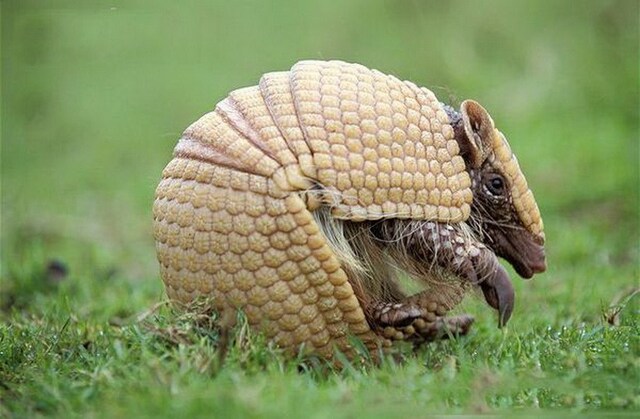
Survival ability
In order to survive, armadillos have full-level defense capabilities. There is a thick and hard armor on the surface of its body. In addition to the armor on its body to defend against enemies, it also has favorable habits such as omnivorous, nocturnal, and able to live in natural caves formed in nature. The habitat can be dense bushes, grasslands, wilderness, and usually there is a shallow pond or mud pit for bathing.
When crawling, armadillos can climb over electric fences and wade in shallow water. If the river is narrow, the armadillo takes a deep breath, dives into the water, and crawls to the other side from the bottom of the river. If the river is wide, it inhales air, fills its stomach, and then swims across.
Armadillos are killed by various carnivorous enemies. These enemies include dogs, bobcats, bears, and coyotes. When threatened, armadillos will run to nearby trees and use dense branches as a barrier, or roll up into a tight ball. If there is a minute or two to hide, it will quickly dig a hole that can tightly wrap its body, making it almost impossible for the attacker to pull it out.
However, the armadillo's biggest natural enemy is still people and vehicles. It is naturally short-sighted and has the habit of foraging for dead prey on the road, so it often appears on the road. The armadillo's "natural startle response" makes the situation worse. Once frightened, the armadillo jumps up and hits the lower part of the passing vehicle.
According to the research of zoologists, the armadillo is one of the animals with the most perfect natural defense ability in the order of mammals. Its defense means can be summarized as: "one escape, two block, three camouflage".
The so-called "escape" means that the speed of escape is quite amazing. When it feels in danger, it can hide its body in the sand at a very fast speed. Although its legs are short, it has a strong ability to dig holes in the soil and dig holes very quickly.
The so-called "block" means that after it escapes into the soil hole, it uses the armadillo's tail armor to tightly block the hole entrance, like a "shield", so that enemies cannot hurt it.
The so-called "camouflage" is the aforementioned curling method, the whole body curls up into a ball, and the body is surrounded by "iron armor" on all sides, so that enemies can't bite it.
Distribution range
Armadillos are distributed in the southern tip of South America, the Caribbean coast, and the Central American continent. The Armadillo family is the largest and most widely distributed family in the order Edentata, including 8 genera and 20 species, distributed in tropical forests, grasslands, semi-deserts and warm climates in Central and South America.
Plains and forests. It has also appeared in southern Africa (Botswana).
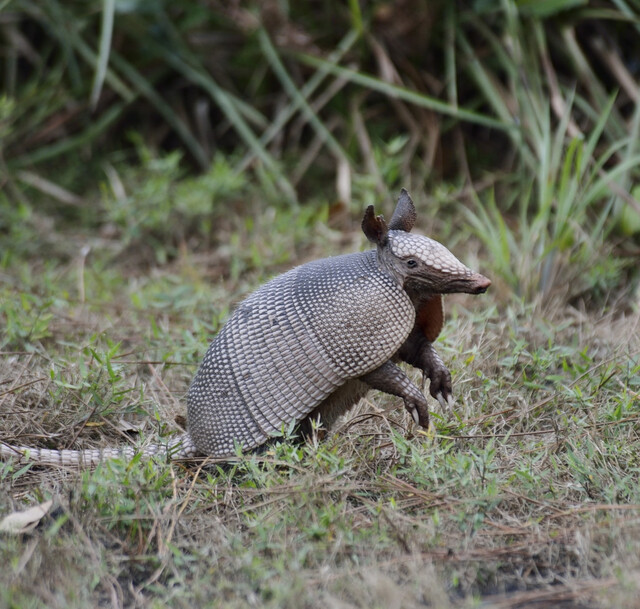
Reproduction method
Armadillos' sexual behavior occurs while running. The length of male armadillos' reproductive organs is one of the longest among all mammals. An armadillo with a body length of only 33 cm has a 15 cm reproductive organ, which is close to half of its body. The reproductive organs of other animals are just enough, but the longer the armadillos are, the better. On the one hand, it is because female armadillos are more willing to choose such males, and on the other hand, it is because the mating activities of armadillos occur while running. Armadillos can reproduce at any time of the year, and male and female armadillos generally occupy different territories. At the end of summer every year, armadillos enter the estrus period. Female armadillos will leave their urine for marking, and males will gradually approach after smelling the female's estrus.
Male armadillos set out to find female mates. During the breeding period, male armadillos will use their special purring to attract the attention of female armadillos. Female armadillos will not mate with each other immediately. Before the formal start, the two sides will chase and play for a while. A female armadillo runs wildly in front, and a group of males chase closely behind. This is the most common scene during the breeding period of armadillos. The fastest one can mate with the female and lie directly on her body. The mating behavior of armadillos occurs during the running process. After mating, they go their separate ways again. What is even more amazing is that female armadillos have a unique physiological function. A fertilized egg will quickly split into two independent eggs, and then split into four independent eggs. The four fertilized eggs of armadillos during pregnancy have the same chromosome structure. Then this division stops, and the fertilized eggs after the division will be kept in the fallopian tube for a period of time. They "swim" in the fallopian tube for about a month before entering the uterus. After the armadillo finds an environment suitable for production, the fertilized eggs will implant. Generally, baby armadillos born in the same litter are of the same sex. This phenomenon gives scientists the opportunity to study how the same set of genes affects the growth and development of animal offspring.
The female armadillo is fertilized once, with four eggs and four litters. The gestation period is 8 months and the longest is 20 months. It can reproduce at any time of the year, and each litter has four babies. The life span is more than 10 years.
Baby armadillos are born after March or April every year, when food is abundant. The body development of baby armadillos is almost complete at birth. Except for the size of the body, they are almost the same as adult armadillos in all aspects. Their armor is soft and easy to bend. As they age, the armor will become harder. A few hours after birth, the baby armadillos can already follow their mothers to forage for food at night. After two months, the baby armadillos will be weaned and go out to find their own territory. Baby armadillos mature in two to three years, unless something unexpected happens.
Sub-classification
Armadillos are rare animals unique to South America and Central America. They mainly live in woods, grasslands and deserts. The Armadillo family includes three families, and now only the Armadillo family remains. There are 9 genera and 21 species of armadillos (1 genus and 1 species are extinct). Zoologists divide this huge family of animals into the following categories according to the number of scale bands: three-banded armadillos, six-banded armadillos, and nine-banded armadillos. For example, the armadillo with three scale bands is called a three-banded armadillo. In addition, there are armored moles, naked-tailed armadillos, South American small armadillos, and hairy armadillos. Among them, there is a king armadillo (also known as a giant armadillo), which can reach a body length of 90cm and a tail length of 50cm. It is almost as big as half a pig and is the boss of armadillos.

Endangered species
Armadillos face many threats and challenges. As their habitats are constantly developed and destroyed by humans, the living environment of armadillos is gradually shrinking. At the same time, the invasion of excessive wild dogs, American bobcats, bears and coyotes also threatens their survival. These invaders will prey on armadillos or compete with them for food resources. In addition, due to global climate change, the food supply that armadillos rely on has also been affected, making their survival more difficult.

A large number of human hunting is also an important factor in the scarcity of armadillos. Armadillos do not look like they can be eaten. Some people want to satisfy their appetite, so they capture armadillos unscrupulously. In the Brazilian Amazon region, armadillos are the main source of meat for local residents. In addition, during the Great Depression, Americans often ate armadillo meat to satisfy their hunger, and also called it and hares "Hoover pigs", which expressed strong dissatisfaction with the economic difficulties faced by the United States under President Herbert Hoover.
Some areas also hunt armadillos and use their hard shells to make ornaments, etc. In this way, under the large-scale hunting of humans, armadillos have become endangered species.
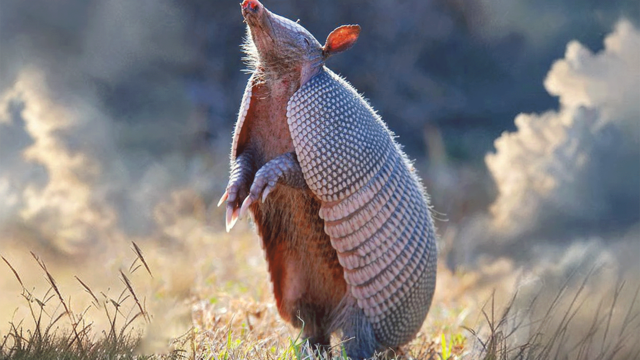
Species hazards
Genetic diseases
For a long time, leprosy was believed by the medical community to be transmitted only among humans. At the end of April 2011, American researchers said that the first leprosy patient in the United States may have been infected by armadillos.
Richard Truman, director of microbiology at the National Leprosy Project of the United States, said: "There is a lot of evidence that humans contract leprosy from this animal." The relevant academic report has been published in the New England Journal of Medicine, and Truman is the main author of the paper.
Every year, about 100 to 150 people are diagnosed with leprosy in the United States. Although many people have been to countries where leprosy is prevalent, it is not known where they were infected.
Most of the patients are in Texas and Louisiana, and these two states are also areas where armadillos carrying Mycobacterium leprae are present. Truman said: "We can provide a connection between the two."
Leprosy is caused by the bacterium Mycobacterium leprae, a close relative of the bacteria that causes tuberculosis. Typically, leprosy patients suffer skin damage; in severe cases, nerve or limb damage.
For years, M. leprae has been difficult to study because it is so prevalent around the world that it is difficult to distinguish. And the bacteria cannot be grown in a lab dish.
Leprosy has a one-year incubation period and develops slowly. In fact, leprosy is so difficult to transmit that only 5% of humans are infected, and even then, they usually need close, repeated contact with M. leprae to eventually develop the disease. In the past, leprosy patients were isolated and lived in leprosy villages. Dr. James Klehenb, director of the National Leprosy Program in the United States, said leprosy is completely curable with a combination of three antibiotics. He said there are about 3,600 leprosy patients in the United States who are not in danger of death. Scientists have long known that armadillos are the only known natural host of Mycobacterium leprae in the world, apart from humans. The small mammals develop the same symptoms as humans, eventually dying from kidney and liver damage. Unlike humans, they are more susceptible to leprosy: in parts of the southern United States, more than 20% of armadillos are sick.
Confirming that armadillos transmit leprosy to humans requires powerful genetic analysis. At the same time, this is also based on the accumulation of rich data in the past decade, comparing the similarities and differences of Mycobacterium leprae genes collected from all over the world.
Scientists have found that leprosy originated in East Africa or the Near East (the eastern Mediterranean coast) as humans migrated to Europe; and in the past 500 years, it has entered Africa and the Americas.
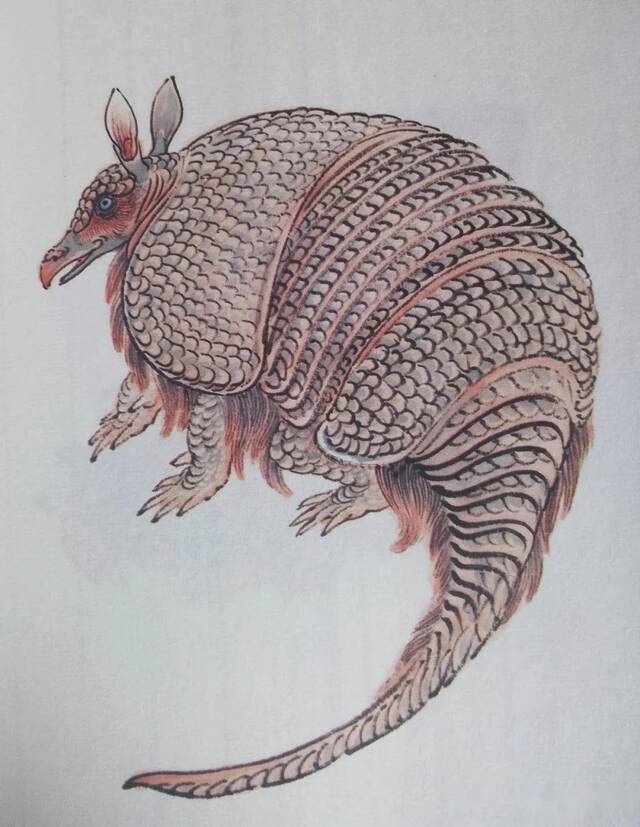
The armadillo (monster) is an ancient mythical beast from the Classic of Mountains and Seas. It looks like a rabbit but has a bird's beak, the eyes of a hawk and the tail of a snake. It lies down and pretends to be dead when it sees people. When it appears, pests such as locusts and crickets will appear and harm crops.
Original introduction
"Classic of Mountains and Seas·Dongshan Erjing": Three hundred and eighty miles south, there is Yu'e Mountain, on which there are many catalpa and nanmu trees, and below which there are many thorns and wolfberries. The Zayu River originates from it and flows eastward into the Yellow River. There is a beast there, which looks like a rabbit with a bird's beak, owl eyes and a snake's tail. It sleeps when it sees people. It is called the armadillo. Its cry is like a cricket, and locusts and crickets will be defeated when it sees them.
Translation explanation
Three hundred and eighty miles south, there is Yu'e Mountain, on which there are dense catalpa and nanmu trees, and below the mountain there are dense thorns and wolfberries. The Zayu River originates from this mountain and flows eastward into the Yellow River. There is a wild beast in the mountains, which looks like a rabbit but has a bird's beak, hawk's eyes and snake's tail. When it sees people, it lies down and pretends to be dead. It is called armadillo, and the sound it makes is the pronunciation of its own name. When it appears, katydids and locusts will appear and harm the crops. The content shows that there are temperate rainforest characteristics in "Classic of Mountains and Seas".

